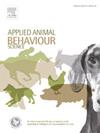Residual feed intake and behavior of sheep: Besides being classified as 'nibblers' or ‘binge eaters', can they also be considered ‘low water drinkers' or 'binge drinkers'?
IF 2.2
2区 农林科学
Q1 AGRICULTURE, DAIRY & ANIMAL SCIENCE
引用次数: 0
Abstract
Physical activity and feeding patterns influence feed efficiency. This study aimed to examine feed and water intake, residual feed intake (RFI), and associated behavioral aspects in young Texel ewes using a multivariate approach. Forty Texel ewes (mean age: 130 ± 7.54 days, mean body weight: 28.98 ± 3.22 kg) were fed at an automatic feed and water station (Intergado®) for 72 days and classified by RFI as low (RFI-), medium (RFI±), or high (RFI+). Principal component analysis (PCA) was used to assess variable influence on the sample distribution. The effect of RFI group on animal behavior was tested via Euclidean distance-based permutational analysis of variance, with effect size calculated using Eta squared (η2). Pairwise post-hoc comparisons were conducted on significant factors. PCA explained 66.6 % of the total variance, identifying key behavioral components related to water and feed consumption. Ewes consumed twice as much water as feed and exhibited more frequent visits to the trough than the drinking fountain. RFI significantly influenced animal behavior, with RFI+ ewes displaying higher water intake and more frequent visits to different feeders compared to RFI± and RFI- ewes. Behavior was most differentiated by water consumption traits, with RFI+ animals showing distinct patterns from RFI± and RFI- groups. These findings highlight the importance of water intake behavior in feed efficiency classification.
羊的残采食量和行为:除了被归类为“啃食者”或“暴食者”之外,它们还可以被视为“低饮水者”或“暴饮者”吗?
体力活动和饲养方式影响饲料效率。本研究旨在采用多变量方法研究年轻特塞尔母羊的采食量和饮水量、剩余采食量(RFI)和相关行为方面。40只Texel母羊(平均年龄:130 ± 7.54日龄,平均体重:28.98 ± 3.22 kg)在自动料水站(Intergado®)饲养72 d,按RFI分为低(RFI-)、中(RFI±)和高(RFI+)。主成分分析(PCA)用于评估变量对样本分布的影响。RFI组对动物行为的影响通过基于欧几里得距离的置换方差分析进行检验,效应大小使用Eta平方(η2)计算。对显著因素进行两两事后比较。PCA解释了66.6% %的总方差,确定了与水和饲料消耗相关的关键行为成分。母羊消耗的水是饲料的两倍,光顾食槽的次数比光顾饮水器的次数要多。RFI显著影响动物行为,与RFI± 和RFI-母羊相比,RFI+ 母羊表现出更高的饮水量,更频繁地访问不同的喂食者。RFI+ 动物与RFI± 和RFI-动物表现出不同的行为模式。这些发现突出了采水行为在饲料效率分类中的重要性。
本文章由计算机程序翻译,如有差异,请以英文原文为准。
求助全文
约1分钟内获得全文
求助全文
来源期刊

Applied Animal Behaviour Science
农林科学-行为科学
CiteScore
4.40
自引率
21.70%
发文量
191
审稿时长
18.1 weeks
期刊介绍:
This journal publishes relevant information on the behaviour of domesticated and utilized animals.
Topics covered include:
-Behaviour of farm, zoo and laboratory animals in relation to animal management and welfare
-Behaviour of companion animals in relation to behavioural problems, for example, in relation to the training of dogs for different purposes, in relation to behavioural problems
-Studies of the behaviour of wild animals when these studies are relevant from an applied perspective, for example in relation to wildlife management, pest management or nature conservation
-Methodological studies within relevant fields
The principal subjects are farm, companion and laboratory animals, including, of course, poultry. The journal also deals with the following animal subjects:
-Those involved in any farming system, e.g. deer, rabbits and fur-bearing animals
-Those in ANY form of confinement, e.g. zoos, safari parks and other forms of display
-Feral animals, and any animal species which impinge on farming operations, e.g. as causes of loss or damage
-Species used for hunting, recreation etc. may also be considered as acceptable subjects in some instances
-Laboratory animals, if the material relates to their behavioural requirements
 求助内容:
求助内容: 应助结果提醒方式:
应助结果提醒方式:


